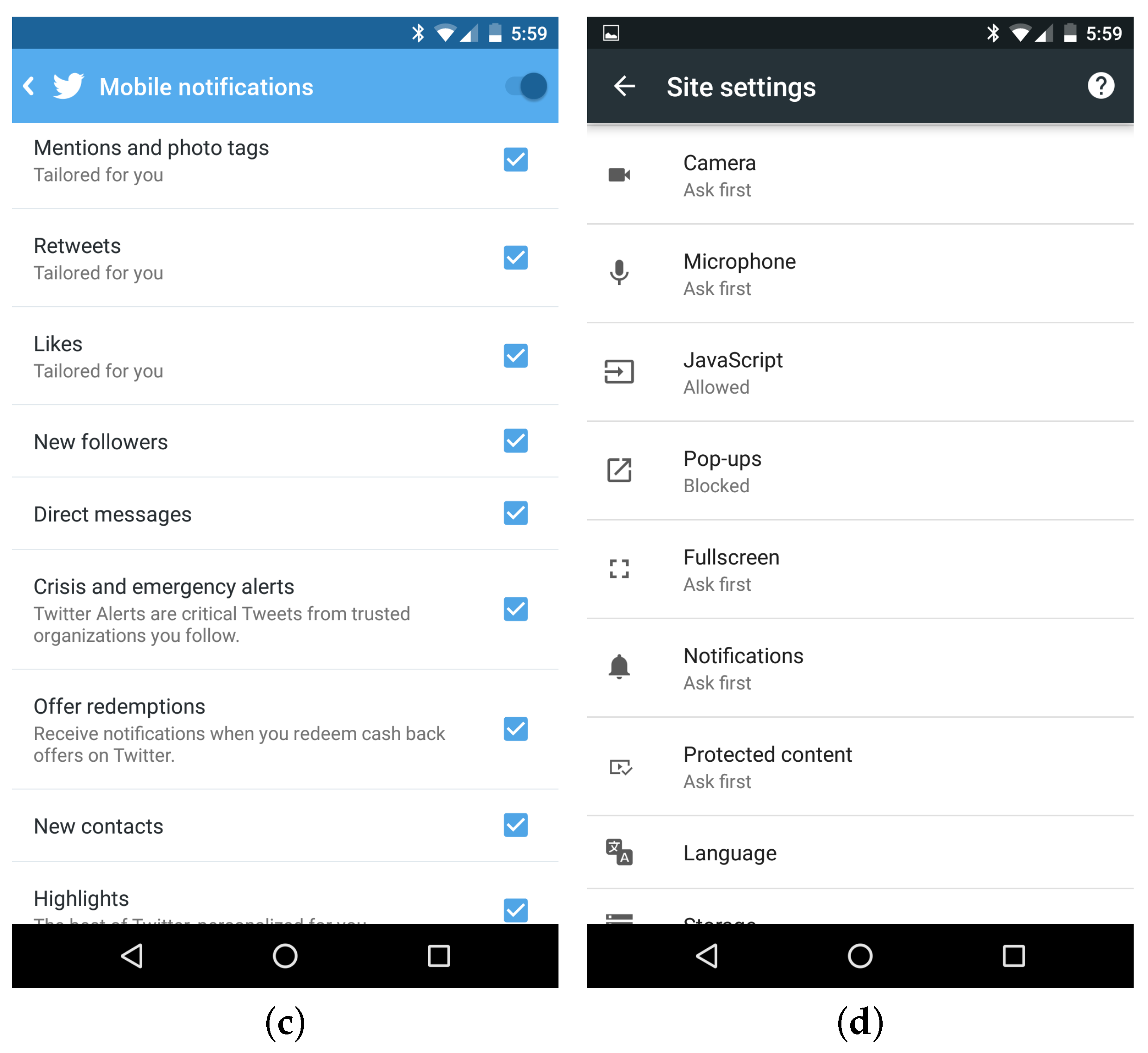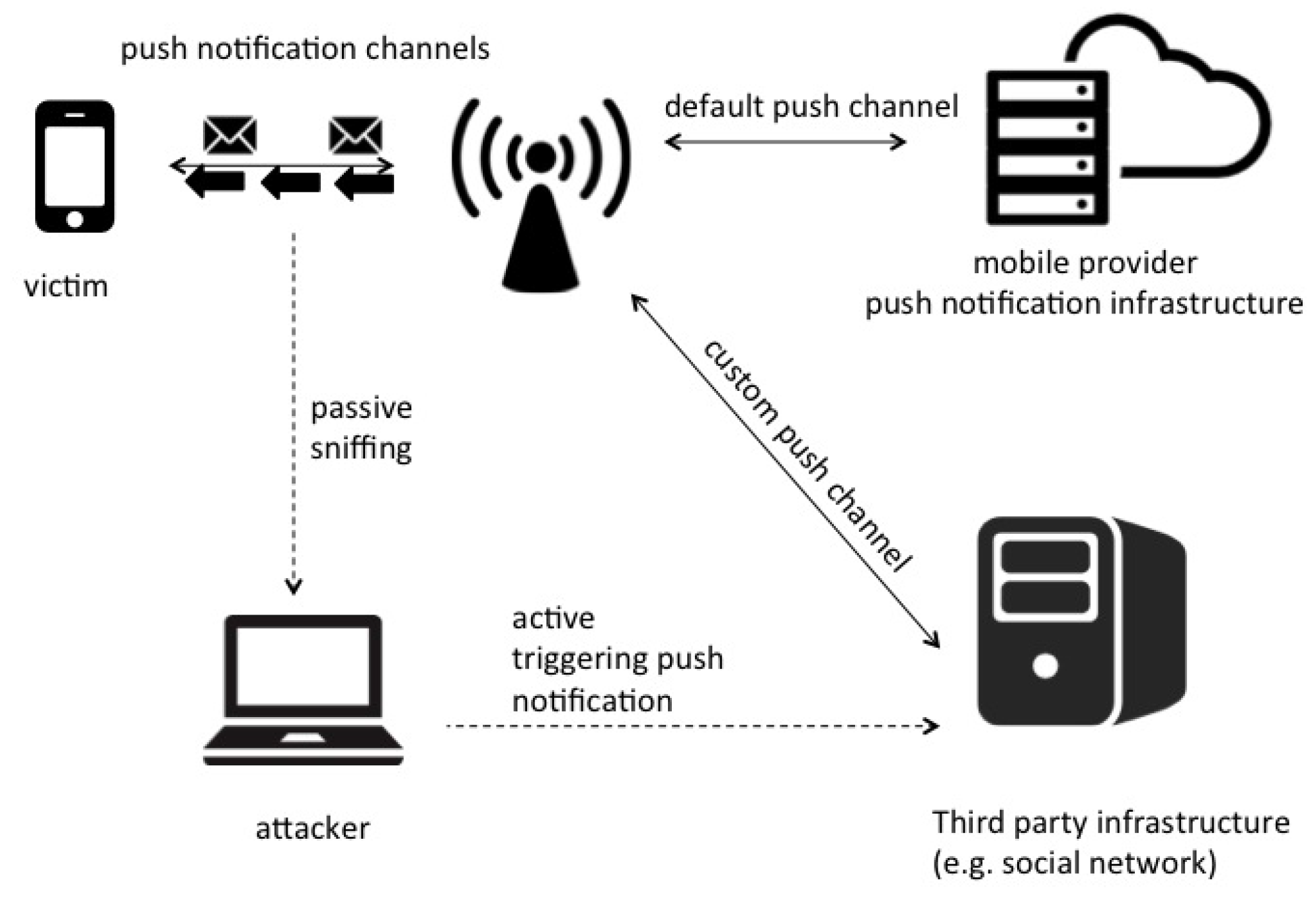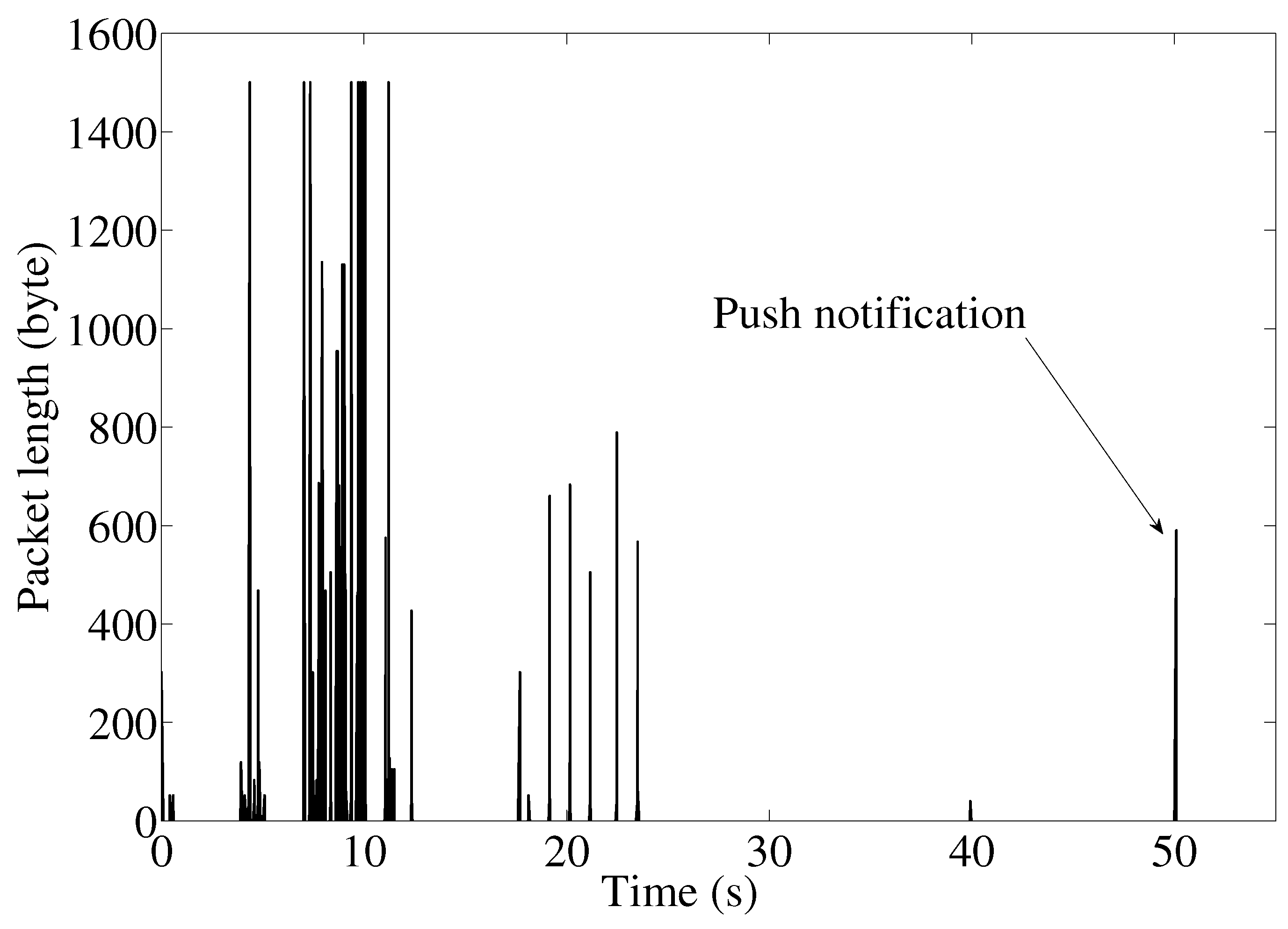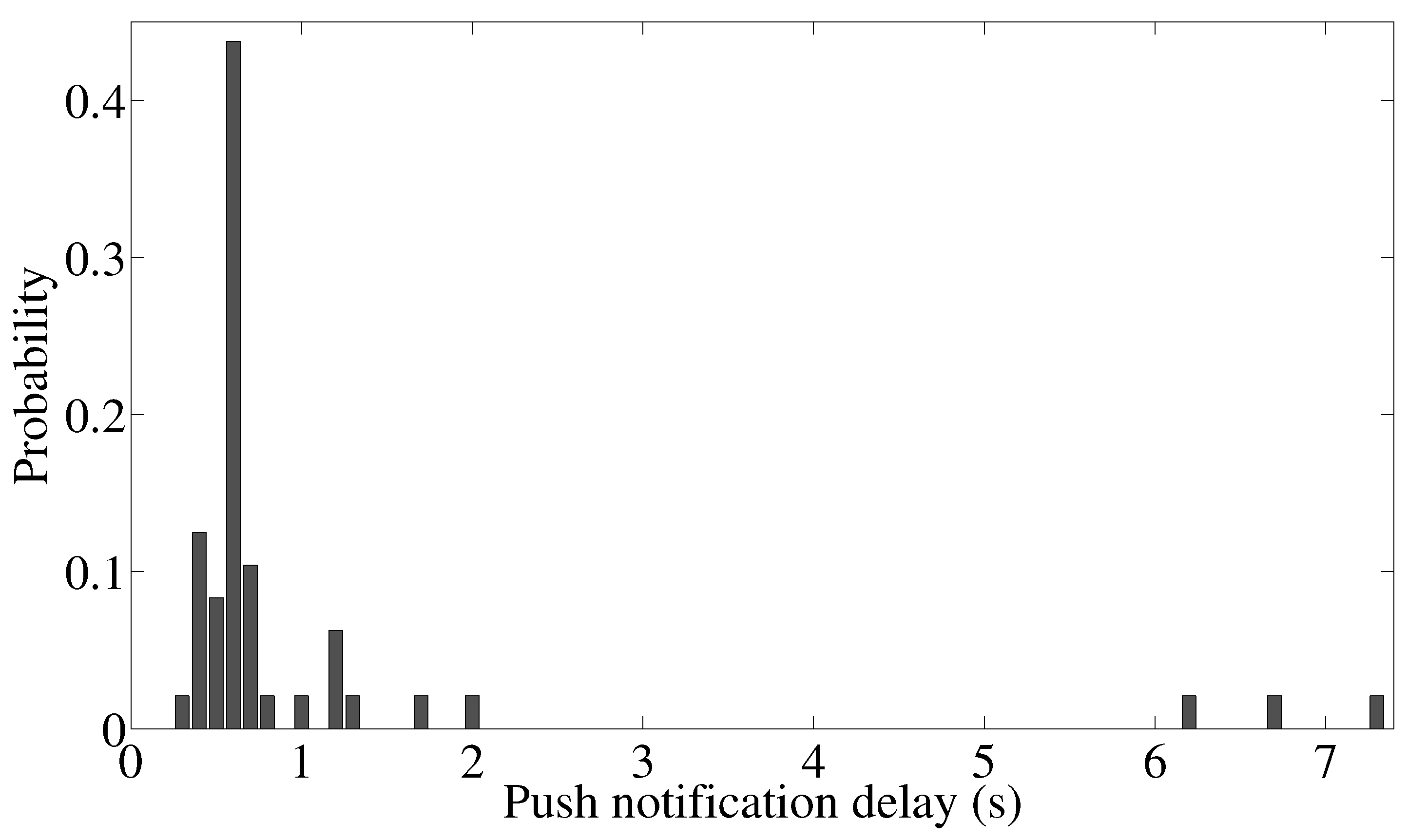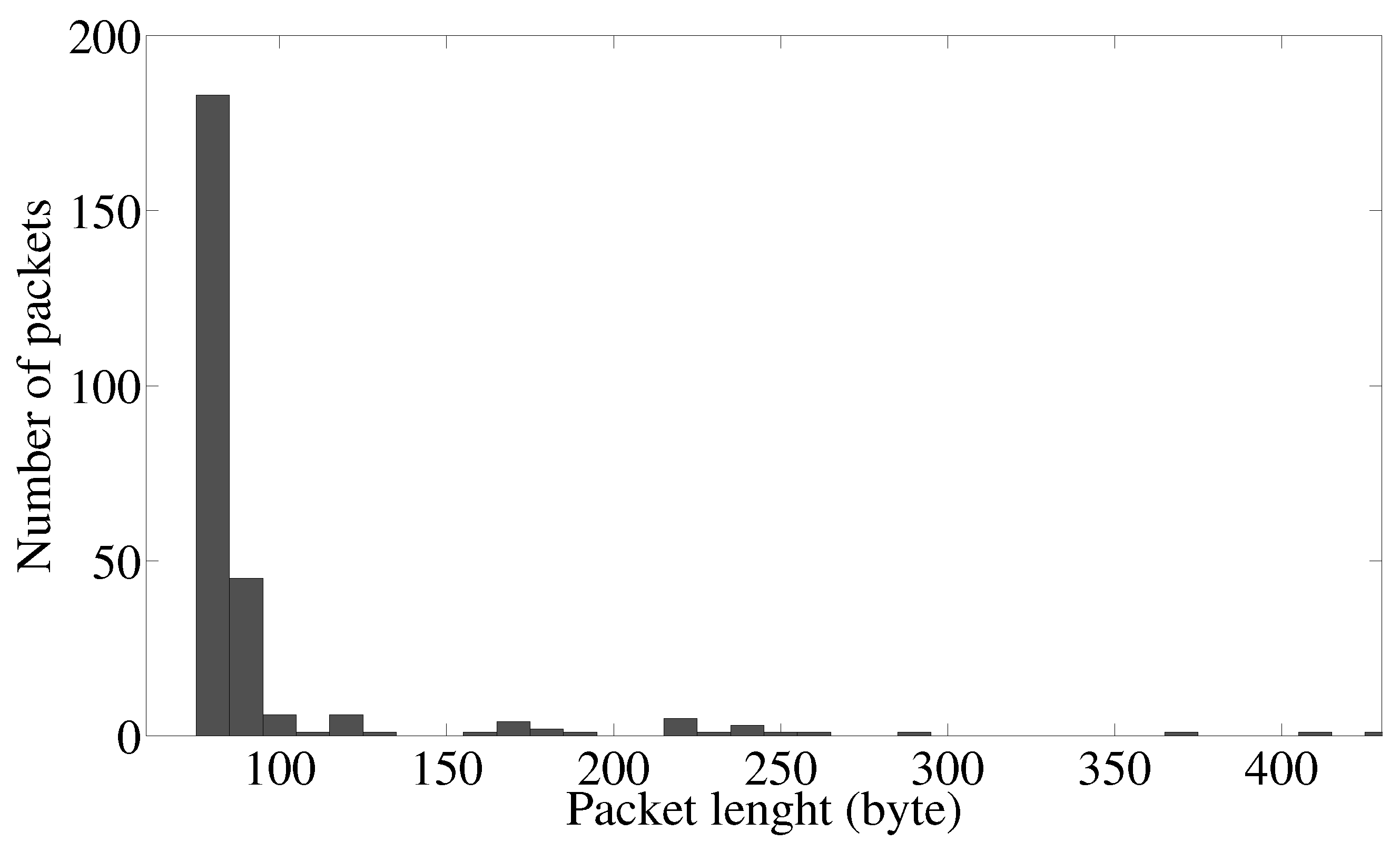1. Introduction
Nearly two-thirds of American adults (64%) currently own a smartphone, and more than 91% of smartphone owners aged 18–29 use social networking at least once a week [
1]. Facebook has
billion monthly mobile active users worldwide (44% of them only log in from a mobile device); Twitter has 252 million monthly mobile active users; Instagram 300 million; while the social dating app Tinder has around 50 million active users per month (source:
http://www.statista.com/).
Besides the big players, a myriad of different applications usually reside on people’s smartphones, allowing their users to play, interact with other users, watch news, etc. To use services (e.g., online social networking, OSN), users must log in to these applications with their accounts. These form their virtual identities.
A virtual identity cannot always be directly traced to the real identity of an OSN user. Pseudonyms represent a simple and easy-to-use way to provide good anonymity. Virtual identities (together with the information associated: political ideas, sexual preferences, etc.) are apparently separated from real identities. In fact, in online social networks, users voluntarily share personal information with the implicit assumption that it is very difficult to link partial information with a person’s real identity [
2]. This assumption is often false or questionable, as there are many attacks attempting to establish these links: structural re-identification attacks, inference attacks, information aggregation attacks and re-identification attacks [
3]. Usually, these techniques use data mining to exploit the correlation among the different information published by one or more people to infer the publisher’s real identity.
A binding between virtual and real identities can lead to several issues in countries that limit civil rights, where people get persecuted for their online activity, when virtual identities reveal very personal or sensitive information or when the real person is a public figure. For this reason, the “real names” policy (the policy that obliges users to identify themselves with their real names, banning the use of pseudonyms) adopted by many online platforms over time brought about several complaints from civil liberties groups. Google apologized and reversed its position (
https://plus.google.com/u/0/+googleplus/posts/V5XkYQYYJqy) (July 2014), allowing users to pick pseudonyms. Furthermore, Facebook recently promised to pay more heed to real-name complaints (October 2015) (
https://www.eff.org/deeplinks/2015/11/facebooks-new-name-policy-changes-are-progress-not-perfection).
In this work, we present a new attack that expressly targets smartphone users to bind their virtual identities with their real ones. Unlike traditional website/desktop applications, smartphone applications have two unique key features:
smartphones follow users everywhere; so the real identity is, in a certain sense, known a priori.
smartphone operating systems implement a push notification service that can be exploited to reveal the virtual identity associated with the device owner as described in this work.
These “push notifications” can be emitted asynchronously by app servers and reach mobile clients, even if the related application is closed or suspended and if the terminal is on standby. Push notifications typically (but not always) create new messages in the notification bar, to keep the user updated on what has happened since the last time the app was opened.
It is not uncommon for mobile applications to need asynchronous communication with a remote server.
Push notifications are extensively used by almost all popular mobile apps and especially by social networking applications, for instance to notify the user about a new social interaction such as a new private message or a new friendship request. Furthermore, browsers are starting to support push notifications from websites, and an IETF working group is outlining Internet Drafts [
4].
Typically, push notifications can be selectively disabled through app/OS settings. Most are enabled by default and are thus usually active (
Figure 1).
If on the one hand, they are usually implemented as asynchronous ciphered messages exchanged through persistent TLS channels, on the other hand, push notifications can be actively triggered. For example, by requesting a social network user’s friendship and by eavesdropping the network traffic, they can unveil the presence of a specific user in a specific location, even if the user is using a pseudonym.
1.1. Use Cases
We believe the attack described in this paper can be applied to many scenarios. We propose three reference use cases.
Marketing Campaigns
Customer profiling and tracking comprise an important asset for OSNs where business is mainly targeted to selling specific advertisements. Evaluating the conversion rate from the outcome of a social media campaign (involving virtual identities) into the number of real customers (involving real identities) represents a big issue for business intelligence. A technique that fills this gap will certainly be of interest.
An exemplary use case is determining how many Facebook contacts expressing their will to participate in an event (a concert, show or demonstration) really attend it. Another is identifying the Facebook profile names of the people in a supermarket. This clearly opens several ethical issues. It does though go in the same direction (even if maybe crossing the line) as location analytic services where WiFi-enabled smartphones can be used to indicate customer presence. Indeed, both commercial (e.g., Cisco Meraki CMX [
5] or open source (e.g., [
6]) software exists that identifies presence, time spent and repeat visits within the range of a WiFi access point by sniffing and analyzing smartphones’ 802.11 probe requests.
Working Place
Conversely, employee privacy is a fundamental right covered by employment laws in many countries all over the world. Employer surveillance versus employee privacy is indeed an open issue [
7].
The privacy attack presented in this paper can reveal the virtual identity of an employee even if they use a pseudonym and a ciphered channel to connect to an OSN. In a workplace, the attack’s feasibility increases thanks to the control on the employee’s Internet access exercised by the boss, making eavesdropping easy.
Government Monitoring
All major OSNs offer tools for law enforcement and publish governments’ information requests for transparency (e.g., Twitter Transparency Reports). At the same time, OSNs have been used to organize riots and protests against governments (2011 Arab Spring Riots) and even to recruit terrorists and to organize attacks (2015 terrorist attack in France and Belgium). This motivates the necessity for governments to reveal users’ identities and track the real position of OSN users.
The attack presented in this work can be applied in such scenarios to track the owners of OSN virtual identities. Having control at the ISP level, and without any right to ask for this information from the OSN owner companies, governments can track down dissidents for licit or illicit purposes. The proposed attack can also be used when collaboration with the OSN is not feasible e.g., darknets or where data retention is not available/implemented by the OSN.
1.2. Privacy Implications
The proposed attack is collocated in the wide area of privacy threats on encrypted traffic, often referred to as side-channel information leaks [
8]. This area and the related privacy implications have been extensively investigated for the desktop scenario (e.g., [
9]). It is recently attracting increasing attention for the mobile scenario. Several works addressed privacy threats and implications because of specific technical and usage characteristics of mobile devices. These include the typical “one app at a time” use [
10], the possible privacy leakage from the use of sensors [
11], location privacy [
12] or, more in general, privacy in mobile environments [
13].
This paper, to the best of our knowledge, is the first to deal expressly with using mobile push notifications to bind real and virtual identities.
As already expressed by the authors of [
14], the disclosure of virtual and real-world identities could raise severe privacy concerns. Linking them can cause even more damage to an individual’s privacy.
Indeed, apparently shielded by pseudonyms and ciphered traffic data (as reported in [
2]), people express themselves more freely on politics, religious or personal topics. Linking their virtual to their real identity could then be embarrassing or even harmful (in 2016, Saudi Arabia sentenced a Twitter user to 10 years in prison for publishing 600 tweets “which spread atheism”).
Finally, the recent IETF Internet Draft [
4] on push notifications also expresses concerns about privacy implications even if from the application’s point of view.
1.3. Contributions
This work wants to provide an answer to the following set of questions:
How do popular applications use push notifications and how can this be exploited to reveal information?
To what extent is it possible to reveal the presence of a user profile using push notifications?
What methodologies does the attack use?
What mitigation techniques are available?
Several works deal with the passive inference of app usage (see
Section 6); to the best of our knowledge, this is the first work examining the use of push notifications for an active attack.
This attack is more difficult to conduct than passive measurements, yet it provides a higher grade of precision. We can repeat a test on a given profile many times, lowering the probability of false positives.
This paper is organized as follows:
Section 2 presents background information on how notifications and push notifications work;
Section 3 presents the details of the proposed attack;
Section 4 presents an implementation of the attack;
Section 5 presents the results of a measurement campaign to better characterize push notifications in the real world. Finally,
Section 6 reviews the present situation, and
Section 7 draws conclusions.
2. Background: How Push Notifications Work
2.1. Built-In Push Notification Service
In a typical usage pattern, push notifications start with a third party app server that contacts the vendor server (e.g., gateway.push.apple.com) using a push notification service API. It asks to deliver a given structured message to a certain registered user of an application, identified by a device ID. The push notification server contacts the mobile device passing the push notification to the operating system when the device is online. When offline, the OS stores the notification for a limited period of time, eventually delivering it to the device, when it becomes available. When a push notification reaches the device, it can be typically (but not mandatorily) shown on the notification bar and optionally trigger application code (this behavior strictly depends on the limits of the mobile operating system).
The benefits of implementing push notification at the system level are two-fold: (i) provide an easy way for application developers to have almost synchronous communication between server and application clients; (ii) optimize power consumption by avoiding several persistent connections (one per app), keeping only one shared connection for all apps, multiplexing, en-queuing and possibly stacking all messages directed to the same mobile device.
Although this general schema is valid, the specific implementation of the push notification service varies by the vendor. In what follows, we briefly describe the case of Android and iOS.
Google Cloud Messaging (GCM) (
https://developers.google.com/cloud-messaging/) was built in 2012 by Google to provide application short messages (up to 4 kB) from a server to Android devices. Even if the source code of the implementation has not been released (being part of the Google Play Store application), some details were publicly and officially released.
Android push notifications work through one persistent TLS connection opened on port 5228 connecting a device with the GCM servers. This connection is monitored and kept open with periodic heartbeats (e.g., every 240 s) and re-established every time the phone connects to a network. The status of this connection is easily accessible by typing
on the phone (
Figure 1a).
2.2. Custom Notification Channels
System notifications also present drawbacks. Besides limits on message size, notification messages can be dropped or delayed. Therefore, some app developers implement their own persistent channel to connect their apps directly with their own servers. See WhatsApp and Facebook on Android.
These channels are usually opened using the system-level push notification service and kept open using keep-alive messages until the user disconnects from the network. In these cases, updates arrive directly from the third party app server to the app on the end user’s device, without passing via the vendor infrastructure. These channels transport proprietary messages processed by dedicated code in the apps. They can optionally result (as with the Facebook app) in a new notification shown in the notification bar of the mobile operating system. Conversely, iOS developers must use the Apple built-in notification channel since they cannot build a persistent socket that remains active when the application is closed or suspended.
2.3. Notifications Bar and Erasable Notifications
Applications decide whether to show notifications in the bar. Developers program this choice. For our purposes, the interesting part is that some notifications can hide previous notifications, thus concealing the attack. This behavior is demanded of the application developer. This is a useful feature adopted for instance by Facebook app developers when a friend request is issued and then revoked. In this case, revoking the friendship request causes the previous friendship notification to disappear from the bar. These “erasable notifications” are perfect to perform an attack without alerting the victim. Facebook friend requests are currently erasable on Android, but no longer on iOS.
3. Attack Description
3.1. Adversary Model
The attacker’s primary goal is to infer users’ personal activities by revealing an exact match between their online (virtual) and real identities. The following reports the attacker’s capabilities.
Packet Sniffing
The attacker is modeled as a semi-passive adversary that can silently sniff packets directed to or originated by the victim. To achieve this, the attacker accesses the target user(s)’ network A semi-passive rival is analogous to the ‘honest-but-curious’ or ‘semi-honest’ adversary model used for security and cryptographic protocols [
15]. This attack can be applied to most wireless environments with public access, e.g., WiFi hotspots in neighborhoods, coffee shops, public events, etc. Replication on cellular networks is discussed in
Section 3.4. We assume that the interesting traffic is encrypted and that the attacker cannot decrypt transport level packets (e.g., TLS). However, the attack can access lower layer protocol information such as IP source and destination addresses, TCP ports and MAC addresses.
Push Triggering
Besides passive network monitoring, the adversary can trigger push notification messages to the target’s personal device using interfaces and actions that are legitimately available on the platform chosen for the attack. For example, a semi-passive adversary can trigger push notification messages by requesting a friendship through an OSN (e.g., Facebook, Twitter, Google+, etc.) or contacting the victim using a messaging platform (e.g., WhatsApp, Viber, WeChat, etc.). The victim must have the related application installed on their mobile device.
Social Data Retrieval
Depending on the type of attack (online, offline), the attacker needs to gather the information on the virtual identities of those users whom they want to bind with their real identities. For example, this information can be the victim’s Facebook profile or activity log on the social network.
3.2. On-Line Attack
The proposed attack consists of actively triggering a push notification message to the victim’s personal device with the aim of capturing the related data packet sent by the OSN platform to the targeted device. The temporal correlation between the triggering and the sniffed data marks the presence of the victim on the observed network.
The attack scenario in
Figure 2 involves the following parties:
Adversary and victim: The attacker and the targeted virtual identity should be on the same network, for example served by the same WiFi access point or connected to the same Ethernet network.
Online platform: This usually is the OSN where the victim is registered and represented by the so-called virtual identity. The platform gives the attacker the functionality to trigger push notifications on the user’s devices.
Push notification infrastructure: This is the framework needed to deliver the push notification. It is either platform-specific (e.g., Facebook notification system for Android devices) in the sense that the platform manages push notifications through its own infrastructure or OS-specific when the OS provider manages the notification infrastructure (mandatory for Apple iOS and a common choice for Google Android).
The full attack comprises the following steps:
- 1
Fill a list of possible profile candidates: the attacker targets victims related to a specific location or habits associated with a physical location providing the network access
- 2
Trigger push notifications to all candidates: the attacker starts to trigger notifications to victims’ devices by soliciting online platform events with a pool of bots. This produces push notifications directed to victims’ devices that the attacker tries to capture where the targeted user could be connected.
- 3
Inspect the data over the air, searching for a well-known data pattern: the attacker collects packets related to push notifications from known platforms (e.g., Facebook, Twitter, WhatsApp, etc.) to detect specific size and time patterns that clearly identify the targeted profile.
Victims often cannot detect the attack since attackers can use specific events triggered by the online platform that erase the previous action. An example is requesting the victim’s friendship as a first step and later erasing the notification (hopefully before the OS displays it) on the victim’s device by removing the friendship request.
Finally, knowing the victim’s device’s MAC address enables user position estimation by passive triangulation or even by active searching. One can repetitively send ICMP echo requests or ARP requests to the device’s MAC address, read the RSSI of the incoming packets and then progressively approach the target.
3.3. Offline Attack
The offline attack has two steps: first, the attacker collects the raw networking data of the monitored location and then correlates this data trace with information crawled from the social network. For example, in Facebook, it is possible to collect timing information on events such as published posts or messages in groups. With this information, the attacker can search the data trace for evidence of the traffic accountable for the push notifications generated by those events.
In this approach, the attacker follows the steps described below:
- 1
The attacker collects all the packets in a given location related to push notifications from all known OSN platforms (e.g., Facebook, Twitter, WhatsApp, etc.) without actively interacting with victims’ profiles.
- 2
The attacker collects data about the timing of the OSN’s events that produced a push notification towards the users.
- 3
The attacker mixes the data acquired in Steps 1 and 2 to find evidence of the presence of a targeted user in the considered location.
Although the offline attack is conceptually feasible and brings about the discovery of information on the targets, we practically focus the present work on the more viable (and easier to test) online approach. The offline attack is suitable when the attacker has a log trace of the connections performed by several users on different hotspots. An example is having access to logs collected for data retention or security purposes.
3.4. Feasibility of the Attack
Two key aspects impact feasibility: (i) how to fill the list of possible profile candidates; and (ii) how to choose the location for the attack. Both are closely related to the specific context examined for the attack. The former aspect can be (i-a) a “profile check” if the attacker wants to test the presence of a single profile identity (e.g., a given pseudonym) in a given location or (i-b) a “profile search” if the attacker wants to detect if some people belonging to a group are in the surroundings.
In both cases, the WiFi’s limited range could hinder the attack. A similar methodology could be used to extend the attack in the case of a wider wireless connection such as LTE (as partially investigated in [
16]). In some scenarios, there is no need to eavesdrop the WiFi packets: when the attacker has control of the network backbone serving the WiFi hotspots.
On top of that, offline and online scenarios present specific difficulties. The online attack forces all profile checks in a limited temporal window due to the victim’s presence in a given location. Once found, the attacker easily pinpoints the victim using active searching techniques as described above. Conversely, an offline attack requires knowledge of the users’ relations (social graph, interaction lists), which sometimes are concealed by the OSN provider according to user privacy settings.
This attack’s strong points are that: (i) it assumes no particular setting on the victim’s mobile device, (ii) it requires no modification of the standard OSN apps, (iii) it requires no particular equipment (a normal laptop with a WiFi card suffices) and (iv) in some cases (see
Section 2), the victim might not even detect it.
As for the differences between the two platforms, we experienced greater technical difficulties in defining the pattern matching on iOS for the reason reported in
Section 2. Anyway, Android currently holds 4/5 of the smartphone market.
One can extend the attack to cellular networks using the Paging Message of LTE triggered by incoming network connections. The work in [
16,
17] adopted this mechanism to track user location. Further investigation on the temporal correlation of LTE paging packets and push notification triggering needs to be carried out to prove the feasibility of the proposed approach on LTE.
3.5. Defense Mechanism
Our technique primarily exploits OSNs’ possibility of exploring users’ habits by triggering a push notification on the user’s device, observing it and exploiting it to infer the victim’s physical presence. This exploit allows the attacker to bind a user’s virtual identity to a real identity, resulting in a breach of personal privacy. It is thus crucial to provide initial advice to prevent this information linking. Solutions like traffic padding and/or morphing [
18,
19] can avoid these attacks, but are usually not feasible since it introduces a high amount of network overhead. This can cause several problems especially for not-so-powerful mobile devices: (i) waste of computational resources, (ii) waste of energy and (iii) waste of network traffic that could become a problem for users with limited bandwidth/traffic. Users need more specific solutions to effectively prevent an analysis of push notifications to their mobile devices. Two features allow the enemy to attack:
Observing the time between the triggering and the effective reception of the packet on the device. It is highly probable that a push notification packet is received on the user’s device shortly after the triggering.
Analyzing the size of received packets. The attacker can distinguish between packets related to different push notifications and thus infer the related triggering functionality (e.g., friendship request or comment liked).
A feasible mitigation could be to develop scheduling algorithms focused on avoiding these information leaks. This scheduling should introduce a random delay on message delivery or collect a certain number of push notifications to deliver before triggering the user device with bulk messages. Obviously, this is feasible when the transmission of push notifications is not time-sensitive (i.e., it is not necessary to deliver the friendship request push notification to the user instantly, but it is important in some cases to receive a chat message). The problem of inferring information by observing packet size could be mitigated by hiding information related to the actual size of data in the packet. This could be achieved by producing randomly-sized padded packets for each push notification. This would prevent the attacker from understanding the functionality that triggered the push notification message, i.e., the attacker cannot distinguish if the received message corresponds to a friendship request or a chat message. In addition to the above, in cases in which the push notification packet is delivered by different servers according to the application (e.g., Android GCM), the attacker has one more features to observe and exploit to infer information. Indeed, knowing the packet’s source releases information about the specific platform that sent the message and can help the attacker filter out other push notification messages. This could be mitigated by multiplexing push notification traffic like APN already does; only one server delivers all push notifications in the same ciphered data channel.
4. Implementation
We tested the attack using the Facebook Android app, as it is the OSN application with most users. The FB app has the following set of notifications enabled by default: post on wall, private messages, comments, friendship requests, friendship request confirmations, tags, events, application requests, groups. We used the friendship request because it generates a push notification even if the sender and receiver are not friends. In the Android version, it is “erasable” as specified in
Section 2; a subsequent friendship request cancellation (revoke) removes any trace in the notification bar, making the attack difficult to spot by the user.
As previously stated, the Android Facebook app does not use the built-in notification system, but sets up, maintains and tears down its own data channel through a persistent Android background service. MQTT [
20] messages originated by or directed to Facebook servers transit on these connections. We can easily separate notification data from regular Facebook browsing using reverse DNS lookups, as the former is addressed to servers whose associated name contains the string ‘mqtt’.
Figure 3 shows the keep alive messages that transit on channel, sent every 60 s to keep the network path up, in an easily recognizable pattern.
When the friendship request arrives, an IP packet of 196 bytes is pushed from the server to the mobile device, followed by a second bigger packet of 615 bytes and a small return packet (85 bytes). Then, a new connection is set up with a different IP address, and a relatively large amount of data is downloaded for a total of 5333 bytes exchanged at the IP level. We suppose these data contain the image and other friendship request meta-data displayed in the notification bar. On the former socket, a small encrypted packet of 195 bytes is sent for the friendship cancellation. This behavior is shown in
Figure 4, where we can see a high peak at
corresponding to the friendship request, followed by a smaller peak at
, which matches the friendship cancellation request.
With reference to the steps described in
Section 3, we implement the push notification attack in the following way.
Step 1: list possible profile candidates:
To perform the attack, we must leverage prior knowledge of where to search for the list of potential profiles to verify. We consider three different cases: Facebook groups, Facebook participants to an event and Facebook profiles that like a given page. Retrieving the list of users in the first two cases is straightforward as we can use the Facebook graph API to fetch all the members of a group (
https://developers.facebook.com/docs/graph-api/reference/v2.4/group/members) or attendees to an event (
https://developers.facebook.com/docs/graph-api/reference/event/attending/). There are no direct APIs for Facebook pages, probably to protect privacy and prevent spam. Then, we use the Facebook social plugin (
https://developers.facebook.com/docs/plugins/page-plugin) designed to embed a widget in a web page showing a random list of people that liked a page. This list gives us a valuable hint about the profiles to check since it includes all users that like a pub, soccer team, political party, campus, conference, course, etc. Using a simple program, we poll this plugin several times to populate the list of possible profile candidates to test.
Step 2: trigger push notifications to all candidates:
Facebook does not provide an API to make friendship requests. By design, Facebook prevents making friendship requests through their Graph API to avoid abuses. Therefore, we use a web browser automation library called Selenium (
http://www.seleniumhq.org/). With this library, we build a pool of bots that log in to the social network with different accounts and process the list of candidates by sending and canceling a friendship request to each one, as shown in
Figure 5. Facebook limits the number of friendship requests to a few dozen (this quota depends on inner mechanisms: empirically, the number of requests toward a target depends on the relationship between requester and target, e.g., if they share friends or are members of the same group), but increasing the number of fake profiles and inserting a delay, we can easily cope with this limitation. We repeat that we choose to use friendship requests for the reason described above. However, using private messages lets us forge packet length, facilitating pattern matching, and sending messages to a group will trigger a notification to all its members, easing the discovery process.
Step 3: Inspect the data over the air, searching for a well-known data pattern:
We put the WiFi interface in monitor mode and sniff the packets over the air. When we observe an IP packet size of 210 bytes (header + payload) coming from port 443 of a Facebook server whose associated name contains ‘mqtt’, we mark the user as potentially revealed. A revoke request is 294 bytes long. In this case, the message transits on the Facebook custom notification channel. Empirically, we see that the size of the packet could vary by a few bytes depending on the length of the Facebook ID. If more statistical guarantees of false positives/negatives are needed, one can repeat the experiment or send a pre-determined number of bytes in a private message to a selected subset of users. To cope with WPA encrypted networks with known passwords (as is the case in many public venues), we pre-process the data with a decrypting program (dot11decrypt) that implements monitor mode on 802.11 networks with WPA/WPA2. The decoded traffic is encapsulated using Ethernet frames and written to a tap device.
With iOS devices, the attack can be conducted in a similar way except that notifications no longer come from custom channels, but from the APN. This makes recognition harder as we cannot filter out the packets coming from Facebook IPs. However, we can filter the Apple subnet to separate push notifications from the rest of the traffic. What we have is aggregated traffic of all push notifications addressed to the device as shown in
Figure 6. Empirically, friendship requests correspond to packets 590 bytes long.
5. Measurements
Being a side channel attack, we are interested in the following information:
To answer the first question, we repetitively trigger Facebook friendship request notifications and measure the time between the triggering and notification delivery to the mobile device, to estimate the application level round trip time (RTT).
Figure 7 reports the empirical distribution of the RTT for a sample of 50 friendship requests. In particular, we recognize the first packet of the push notification that, in turn, triggers other connections responsible for fetching accessory data needed to properly display the notification (e.g., fetching the requester’s profile image). Therefore, even if the notification is viewed on the mobile device after several seconds, the packet of interest can be captured after, on average 1.08 s. Despite it being far bigger than the end-to-end network delay (measured at 12 ms), the application RTT is fast enough to enable quite a precise correlation between the triggering of the mobile notification and the packet’s detection on the network.
As for the second question, we point out that while the attack is performed, victims can also receive push notifications originated by regular application behavior (e.g., a regular friendship request). The attacker can mistake these push notifications for the ones they originated for the attack. In this case, the attacker may erroneously associate a user’s identity with the wrong virtual identity, leading to a false positive detection.
Because the attacker knows the length of the push notification that they are searching for, the false positive ratio depends in turn on the distribution of the lengths of push notifications received by users. For instance, a push notification of 196 bytes can be erroneously attributed to a friendship request event.
To estimate the false positive rate and to tune the parameters of the attack, we conduct a measurement campaign in several different environments: a bar, a concert hall, a popular fast-food restaurant, a square, a library. We choose environments where most users connect to the free WiFi with their mobile phones, and we analyze 2 GB of mobile traffic. We extrapolate from the captured data the distribution of the lengths of the push notification messages from Facebook servers to clients. As we can see from
Figure 8, the high spike at 66–97 bytes derives from the keep-alive mechanism. The other lengths are quite evenly distributed from 100 to 430 bytes. This fact, on the one hand, suggests the possibility of forging custom length notifications (e.g., private messages) to better cope with a possible false positive detection. On the other hand, the relatively low number of notifications in 2 GB of sniffed traffic demonstrates that application-specific push notifications are quite rare events. This ensures a high degree of precision even in the case of fixed size notifications such as friendship requests.

